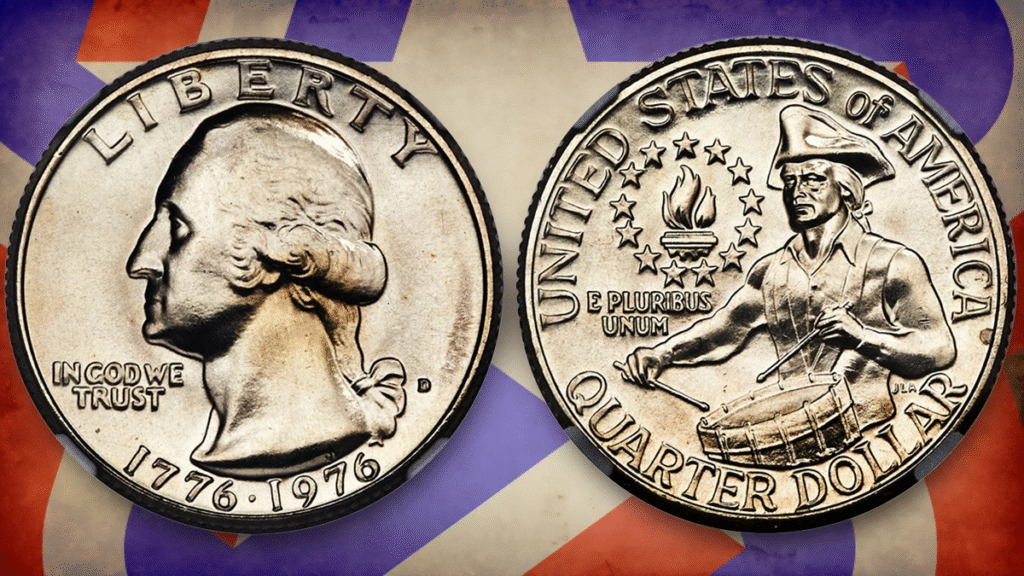The Bicentennial quarters in 1976. Most of these quarters cost only 25 cents, but some rare types are sold by millions, even millions. Some unbalanced reports also claim that some examples may be up to $ 20 million under some circumstances.
But separates one Bicentan quarter from another? Can you inadvertently change your pocket? Let’s find out conspiracy, history and hidden money related to this cute coin.
What is Bicentennial Quarter from 1976?
To celebrate the 200th anniversary of the American Independence, in 1975 and 1976, the US special monuments were issued by Mint. These were the quarters, half dollars and dollars coins – with every specific design that was never worked before or after.

Bicentantiial Quarter Jack L. Ahhar replaced the standard Eagle Reverse with a picture of the drummer boy in a colonial time. Oberg (in front) placed the profile of George Washington, but now with a double date: “1776–1976” to convince Bicentanial.
This quarter was minted in huge numbers to satisfy circulation and collector demand—more than 1.6 billion quarters were minted. Yet very few were minted in 40% silver for collector sets, and a few are so rare in errors that they have soared in value.
How Can a Bicentennial Quarter Be Worth $20 Million?
The concept of a $20 million quarter might be laughable, but it is founded on a mix of circumstances that can render some coins incredibly valuable:
1. Ultra-Rare Mint Errors
Minting errors double dies, off-metal strikes, or planchet errors can render a coin extremely rare. A Bicentennial Quarter struck unintentionally on a 1974 planchet or foreign coin metal, for instance, could be worth a whopping amount because of its uniqueness.
2. High-Grade Proofs
A well-preserved proof coin graded PR70DCAM (deep cameo) by PCGS or NGC can fetch thousands hundreds of thousands at auction. If paired with an error or a rare material, the figure can go even higher.
3. 40% Silver Composition
The U.S. Mint produced 40% silver Bicentennial quarters for collector sets. Most are worth between $5 and $10, but higher-grade or error silver coins can fetch into the five- or six-figure category.
4. Private Sales and Collector Demand
It is whispered that a very rare specimen was privately appraised or sold for as much as $20 million, although these types of sales are seldom confirmed. Nevertheless, renowned collectors are not afraid to pay enormous prices for unique, historically relevant coins.
Key Details to Identify a Valuable Bicentennial Quarter
If you wish to determine whether you possess a rare Bicentennial Quarter, check the following:
Mint Mark
- No mint mark: Philadelphia Mint
- “D”: Denver Mint
- “S”: San Francisco Mint
Coins with an “S” marking were usually proof or silver strikes. These are more desirable, particularly if they are uncirculated.
Material
- Clad Copper-Nickel: Common circulation coins
- 40% Silver: In special collector sets; weigh it (~5.75 g vs. 5.67 g for clad).
Weight
- Use a digital scale.
- Clad: ~5.67 grams
- Silver: ~5.75 grams
- Odd weight = possible error or off-metal planchet
[also_read id=”449″]
Design Quality
- Coins with unusually sharp detail, mirror-like fields, or deep cameo contrast tend to be proofs. Those doubled letters or doubled numbers can be double dies, and these are highly sought-after errors.
Top Valuable Bicentennial Quarters Sold
Below are some actual auction prices that demonstrate the demand for rare Bicentennial Quarters in the market:

| Grade / Type | Auction Price | Notes |
|---|---|---|
| PR69DCAM Silver Quarter (S) | $4,000–$5,000 | Near-perfect proof |
| MS67+ Clad (D or no mint) | $3,000–$7,000 | Rare uncirculated high grade |
| 40% Silver Error (Off-Center) | $10,000+ | Mint error + silver composition |
| Unknown Composition w/ Error | Up to $20 million* | Private, unverified claim |
Some accounts indicate that such coins are either in private reserves or dealer vaults and are being estimated at multimillion-dollar levels due to their rarity.
How to Authenticate Your Bicentennial Quarter
If you think you’ve got a valuable coin, DO NOT clean it this decreases its value significantly.
Here’s what to do instead:
- Use a Magnifying Glass or Microscope: Inspect for details, mint mark, and doubling.
- Weigh It: Monitor for irregularities.
- Compare Against Grading Standards: Utilize PCGS or NGC guides.
- Submit for Authentication: Mail to a serious grading firm:
- PCGS (Professional Coin Grading Service)
- NGC (Numismatic Guaranty Company)
These companies will authenticate your coin, grade it, and list it in a public registry increasing both validity and resale value.
Why the Bicentennial Quarter Is Important
Whether your coin is a million dollar tax or not, Bicentennial Quarter is the item to a basic collector as it remembers a winning moment in American history. Collector wants these coins for its beauty, their historical significance and discovery enthusiasm.
Read More:- 8 Roosevelt Dimes Worth Over $1.9 Million Still Found in Circulation
For beginner coin collectors, it’s an awesome way to get started in numismatics. For experienced pros, it’s an opportunity to find a gem in plain sight from the most mundane locations such as your coin piggy bank or wallet.
Conclusion: Start Looking—The $20 Million Quarter May Be Yours
With more than one billion Bicentennial Quarters produced, the majority are worth only face value. But from the masses, a few have been legendary due to their rarity, error types, or silver content. These rare ones are worth thousands, sometimes even millions.
Might one of these ancient treasures be nestled in your pocket or coin collection? One way to know for certain begin inspecting your change. You never know when that humble 25-cent coin will prove to be worth $20 million.
FAQs:-
What makes a 1976 quarter worth $20 million?
Extremely rare variants with double dies, off-metal strikes, or unique minting anomalies can reach astronomical auction values.
What does the Bicentennial Quarter look like?
It features a colonial drummer on the reverse and the dual date “1776–1976” on the front under George Washington’s portrait.
What errors should I look for on a 1976 quarter?
Look for doubled dies, off-center strikes, missing mint marks, or any unusual coloration or texture.

Shreya Singh is a dedicated financial journalist known for her in-depth coverage of government programs and economic updates. She consistently delivers accurate information on U.S. topics such as Stimulus Checks, IRS announcements, and federal relief efforts. Shreya also reports on UK welfare programs, covering developments in Universal Credit, PIP, and DWP news. Her clarity and commitment to trustworthy reporting have earned her a loyal following among readers seeking insightful financial updates.
